ikfoundation.org
Promoting Natural & Cultural History



ESSAYS |
BOLSTERS AND PILLOWS
– Swedish Weaving Traditions and Historical Reproductions
Durable handwoven striped woollen qualities used for warm feather/down bolsters and pillows were popular in many Swedish farming communities for centuries. These textiles – named “bolstervar” – were sometimes stuffed with straw, reeds, horsehair grass or other easily acquired materials instead. In the southernmost province, Skåne, evident already in the early 18th century, via estate inventories listing ‘blue striped feather bolsters’ among many similar bedclothes in 1702. A weaving tradition, which will be looked at more closely in this picture essay, represented in handwritten documents, artworks and extant fabrics – over two centuries, up to around the year 1900. The skilful weavers of the later period seem to have preferred bright aniline dyes in reds and greens on a white ground, textiles often well-preserved up to the present in museum collections and private homes. Some examples from my own linen cupboard and practical handloom weaving aim to give further aspects of these beautiful fabrics.
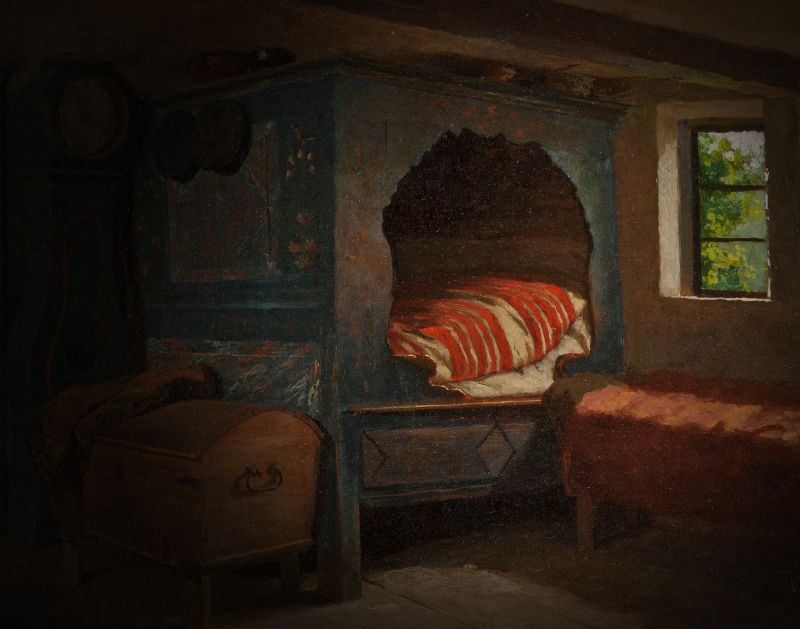 ‘Interior of a Farmer's Cottage in Skåne’, with traditional textiles and furnishing. Particularly notice the blue-painted box bed with a feather-stuffed woollen striped red and white bolster. In southernmost Sweden, the weaving itself was almost entirely women’s handicraft and often part of dowry preparations for daughters in a rural domestic sphere – in contrast to paid weavers working in urban manufactures, who mainly consisted of men. | Oil on canvas by Jakob Kulle (1838-1898). (Courtesy: Nationalmuseum, Stockholm, Sweden. NM 5323, part of. Wikimedia Commons).
‘Interior of a Farmer's Cottage in Skåne’, with traditional textiles and furnishing. Particularly notice the blue-painted box bed with a feather-stuffed woollen striped red and white bolster. In southernmost Sweden, the weaving itself was almost entirely women’s handicraft and often part of dowry preparations for daughters in a rural domestic sphere – in contrast to paid weavers working in urban manufactures, who mainly consisted of men. | Oil on canvas by Jakob Kulle (1838-1898). (Courtesy: Nationalmuseum, Stockholm, Sweden. NM 5323, part of. Wikimedia Commons).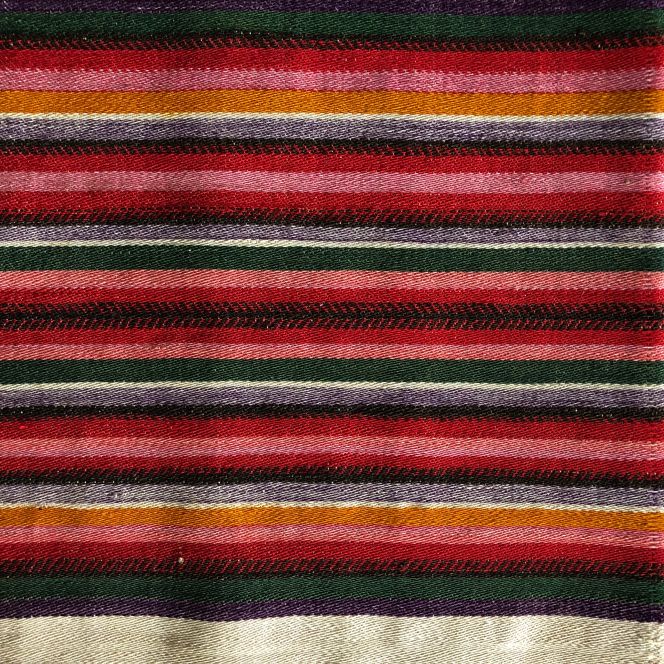 Striped multicoloured chevron twill, dating late 19th century. Judging by extant textiles of this kind from southernmost Sweden, chevron twill was the preferred weaving technique. Overall, it was relatively straightforward to weave on four treadles, using a shuttle with the finest possible machine-spun woollen yarn in a weft-faced twill on a cotton warp (not visible in this weaving technique). The fabric is sturdy, durable, and handwoven with great attention to detail – counting 28-30 woollen weft threads per centimetre. A five-shafted satin was another used technique for similar styled striped woollen fabrics within the comfortable living farming communities in the southerly province of Skåne. Linen warp was used for this type of traditional textile before industrial spinning in the early 19th century. (Private ownership). Photo: Viveka Hansen, The IK Foundation.
Striped multicoloured chevron twill, dating late 19th century. Judging by extant textiles of this kind from southernmost Sweden, chevron twill was the preferred weaving technique. Overall, it was relatively straightforward to weave on four treadles, using a shuttle with the finest possible machine-spun woollen yarn in a weft-faced twill on a cotton warp (not visible in this weaving technique). The fabric is sturdy, durable, and handwoven with great attention to detail – counting 28-30 woollen weft threads per centimetre. A five-shafted satin was another used technique for similar styled striped woollen fabrics within the comfortable living farming communities in the southerly province of Skåne. Linen warp was used for this type of traditional textile before industrial spinning in the early 19th century. (Private ownership). Photo: Viveka Hansen, The IK Foundation.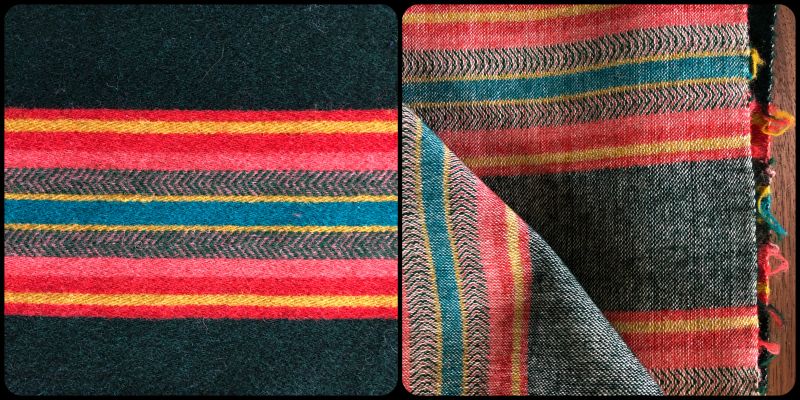 The front and back of this second late 19th century striped woollen fabric in chevron twill demonstrates the once preferred choice of even more intense aniline colours. Other features visible at the back are the dimly seen white cotton warp and the way the ends of the wool weft are left in the selvedge between the colour changes. Due to that, during the time of the weaving, the selvedges were never meant to be visible, as they were hidden inside the feather bolsters or cushions when stitched together. It may also be noted that large numbers of similar striped 19th century fabrics were sold at local auctions as late as in the 1980s and at times never used, like this visualised example, which is still unused up to this day. These were qualities which had been stacked in chests and cupboards in abundance for one hundred years or even longer, once woven for the purpose of extraordinarily rich dowries in the comfortable living farmers’ households in the southeastern part of Skåne. (Private ownership). Photo: Viveka Hansen, The IK Foundation.
The front and back of this second late 19th century striped woollen fabric in chevron twill demonstrates the once preferred choice of even more intense aniline colours. Other features visible at the back are the dimly seen white cotton warp and the way the ends of the wool weft are left in the selvedge between the colour changes. Due to that, during the time of the weaving, the selvedges were never meant to be visible, as they were hidden inside the feather bolsters or cushions when stitched together. It may also be noted that large numbers of similar striped 19th century fabrics were sold at local auctions as late as in the 1980s and at times never used, like this visualised example, which is still unused up to this day. These were qualities which had been stacked in chests and cupboards in abundance for one hundred years or even longer, once woven for the purpose of extraordinarily rich dowries in the comfortable living farmers’ households in the southeastern part of Skåne. (Private ownership). Photo: Viveka Hansen, The IK Foundation.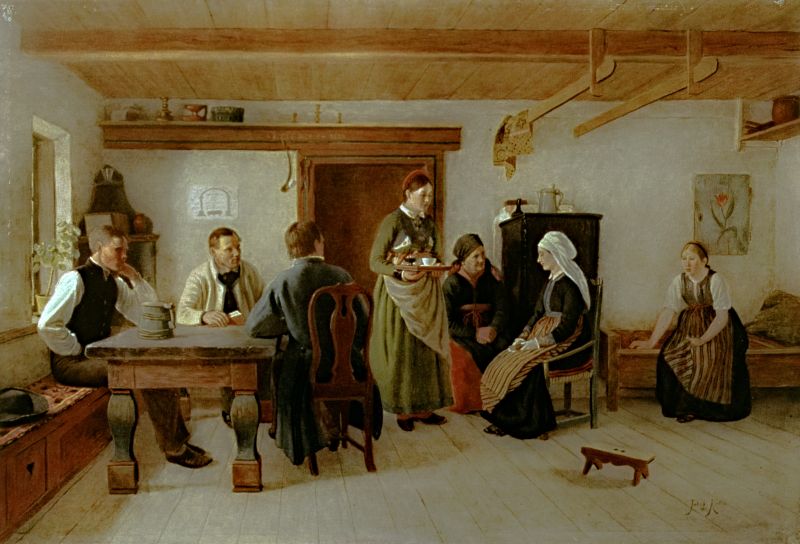 This oil on canvas shows a Sunday morning from a farmer’s home in Torne district, Skåne c. 1870s. Several traditional textiles are visible in this artwork, in the form of a bench cover woven in double interlocked tapestry, cushions with non-identifiable techniques, a decorative art woven cover hanging above the stove and of particular interest here – a glimpse of a striped bolster in red and white on the bed with the sitting girl. The artist Jakob Kulle (1838-1898) made several depictions of everyday life in the rural area of Skåne. However, he was not solely a painter; studies of historical textiles were another area of his expertise, which is clearly visible in this depiction as well as in the introduction image of this essay. (From: Cederblom, G., Svenska folklivsbilder, fig 85, 1923).
This oil on canvas shows a Sunday morning from a farmer’s home in Torne district, Skåne c. 1870s. Several traditional textiles are visible in this artwork, in the form of a bench cover woven in double interlocked tapestry, cushions with non-identifiable techniques, a decorative art woven cover hanging above the stove and of particular interest here – a glimpse of a striped bolster in red and white on the bed with the sitting girl. The artist Jakob Kulle (1838-1898) made several depictions of everyday life in the rural area of Skåne. However, he was not solely a painter; studies of historical textiles were another area of his expertise, which is clearly visible in this depiction as well as in the introduction image of this essay. (From: Cederblom, G., Svenska folklivsbilder, fig 85, 1923).![To be compared with the bed textile in the painting above, this well-preserved striped feather bolster was woven in a very densely beaten twill, and as customary after the weaving, due to the limited handloom width, two identically woven lengths of fabric had to be stitched together to get the required width. Furthermore, this particular warming feather bolster is part of the so-called Onsjöstugan [cottage from Onsjö], initially located in the central part of Skåne province, but for many years back at the open-air museum Kulturen. The museum aims to show how such a cottage used to be furnished around the year 1850, among other sources, with similar furniture and household objects as were stated in estate inventories after Sven Andersson and his wife, Gunilla Andersdotter, dated 1842 respectively 1865, who lived in this cottage. (Collection: Kulturen in Lund, Sweden). Photo: Viveka Hansen, The IK Foundation.](https://www.ikfoundation.org/uploads/image/6-a-bolstervar-kulturen-800x390.jpg) To be compared with the bed textile in the painting above, this well-preserved striped feather bolster was woven in a very densely beaten twill, and as customary after the weaving, due to the limited handloom width, two identically woven lengths of fabric had to be stitched together to get the required width. Furthermore, this particular warming feather bolster is part of the so-called Onsjöstugan [cottage from Onsjö], initially located in the central part of Skåne province, but for many years back at the open-air museum Kulturen. The museum aims to show how such a cottage used to be furnished around the year 1850, among other sources, with similar furniture and household objects as were stated in estate inventories after Sven Andersson and his wife, Gunilla Andersdotter, dated 1842 respectively 1865, who lived in this cottage. (Collection: Kulturen in Lund, Sweden). Photo: Viveka Hansen, The IK Foundation.
To be compared with the bed textile in the painting above, this well-preserved striped feather bolster was woven in a very densely beaten twill, and as customary after the weaving, due to the limited handloom width, two identically woven lengths of fabric had to be stitched together to get the required width. Furthermore, this particular warming feather bolster is part of the so-called Onsjöstugan [cottage from Onsjö], initially located in the central part of Skåne province, but for many years back at the open-air museum Kulturen. The museum aims to show how such a cottage used to be furnished around the year 1850, among other sources, with similar furniture and household objects as were stated in estate inventories after Sven Andersson and his wife, Gunilla Andersdotter, dated 1842 respectively 1865, who lived in this cottage. (Collection: Kulturen in Lund, Sweden). Photo: Viveka Hansen, The IK Foundation.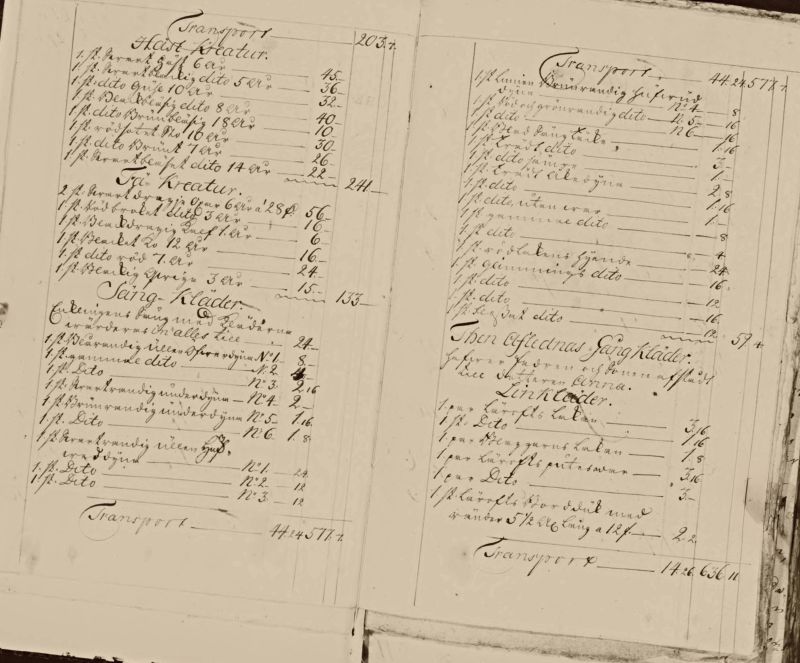 Estate inventory from Oxie district, Skåne province, Sweden in 1760. (Courtesy: Riksarkivet, Oxie häradsrätts arkiv, bouppteckningar. SE/LLA/10050/FII/11, 1760-1761. Image: C0109793-00012).
Estate inventory from Oxie district, Skåne province, Sweden in 1760. (Courtesy: Riksarkivet, Oxie häradsrätts arkiv, bouppteckningar. SE/LLA/10050/FII/11, 1760-1761. Image: C0109793-00012).A closer observation of estate inventories in Oxie district, close to the harbour city Malmö – every ten years during 150 years – stretching from 1700 to 1850, reveals the abundance of woollen striped feather bolsters and pillows in many rural households. This illustrated example referred to the deceased farmer’s wife, Elna Pehrsdotter, in Staffanstorp village on the 26th of September 1760. Below ‘Säng-kläder’ [Bed-clothes], it was listed in translation: ‘The widower’s bed with bedclothes, valued in all to 24 Daler Copper coins’, to be continued with: ‘1 blue striped woollen feather bolster No.1’ and after that 13 further striped bed textiles of various sizes, some of these mentioned as old. Overall, during these 150 years, woollen and linen feather bolsters and cushions were often mentioned as ‘striped’ and were undoubtedly one of the most essential textile categories for a long time in the farmers’ homes. It was important for warmth, durability, comfort, and not to forget the substantial value of such household textiles. It may also be noted that already in one of the earliest estate inventories from this district, dated 1702, it is evident that woollen bedclothes for feather bolsters and cushions were listed as ‘blue striped woollen’. That is to say; it seems to have been particularly important to record ‘blue’ due to the high status of this colour, both for the reason of the complex process with vat-dyeing but also because there was, in fact, only one plant in Sweden which yielded blue dye, woad (Isatis tinctoria). Later, during the 18th century, imported indigo (Indigofera tinctoria) was used more significantly in parallel with domestic and imported woad. However, blue colours were still held in high esteem up to the introduction of chemical dyes in the 1850s.
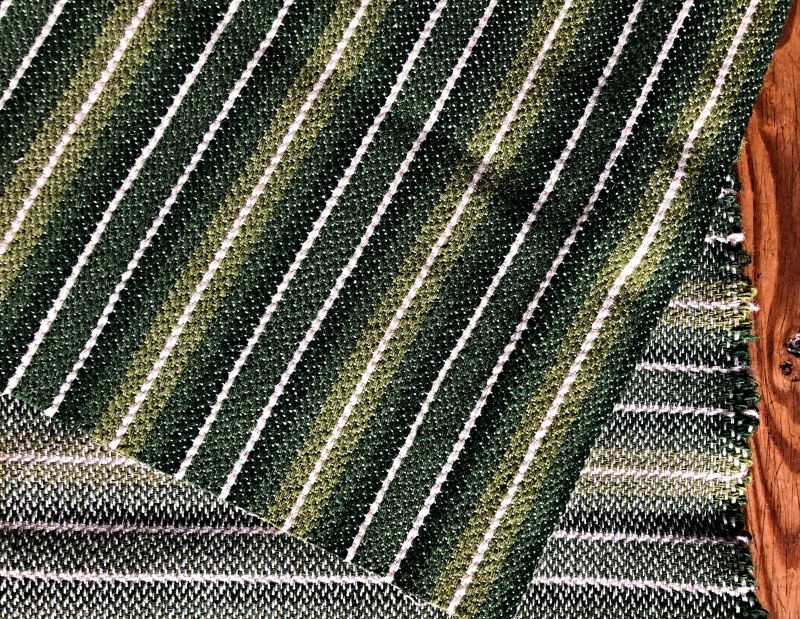 This picture essay will conclude with two examples of my weaving. This first weft-faced broken twill on a white cotton warp and striped woollen weft was woven after the same tradition in a similarly constructed handloom as the 18th- and 19th-century woollen fabrics discussed above. | Front and back of the material. (Private ownership). Photo and woven fabric: Viveka Hansen, The IK Foundation.
This picture essay will conclude with two examples of my weaving. This first weft-faced broken twill on a white cotton warp and striped woollen weft was woven after the same tradition in a similarly constructed handloom as the 18th- and 19th-century woollen fabrics discussed above. | Front and back of the material. (Private ownership). Photo and woven fabric: Viveka Hansen, The IK Foundation.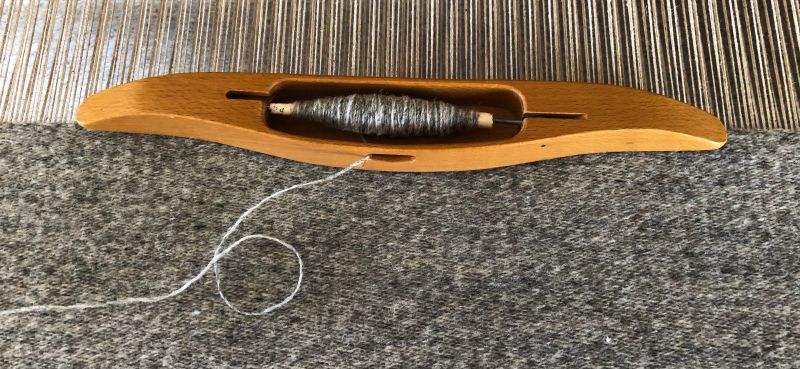 This ongoing twill weave on a cotton warp with one-ply grey wool yarn clearly shows how the densely beaten weft-faced technique covers the warp threads – resulting in a durable quality. My aim with several twill weaving experiments has not been to copy the “old styled” designs but, rather, to better understand hand-weaving traditions in southernmost Sweden and to get long-lasting furnishing textiles for the home. (Private ownership). Photo and weaving: Viveka Hansen, The IK Foundation.
This ongoing twill weave on a cotton warp with one-ply grey wool yarn clearly shows how the densely beaten weft-faced technique covers the warp threads – resulting in a durable quality. My aim with several twill weaving experiments has not been to copy the “old styled” designs but, rather, to better understand hand-weaving traditions in southernmost Sweden and to get long-lasting furnishing textiles for the home. (Private ownership). Photo and weaving: Viveka Hansen, The IK Foundation.TERMINOLOGY | The textile term “bolstervar” – a coarse woollen cloth with horizontal woven stripes, usually in up to five to seven contrasting colours, in a weft-faced technique on a one-coloured linen or cotton warp – does not seem to have an exact translation into English. However, this is not entirely unusual for traditionally woven textile techniques in the 18th and 19th centuries. One may even use several other translated terms than bolsters depending on the size and usage for such warm bedding fabrics – bedticks, featherbeds, cushions, or even duvets or comforters.
Sources:
- Brodén, Märta, Vävning: andra boken, Stockholm 1981.
- Cederblom, Gerda, Svenska folklivsbilder, Stockholm 1923.
- Cyrus-Zetterström, Ulla, Handbok i vävning: Bindningslära – konstvävnader, Helsingborg 1980.
- Hansen, Viveka | Historical reproduction: practical weaving of striped and single-coloured qualities.
- Kulturen in Lund, Sweden (Striped feather bolster on display and information about ‘Onsjöstugan’: visit in May 2022).
- Landsarkivet in Lund, Sweden (Oxie häradsrätts arkiv, bouppteckningar 1700-1850. | Research via digital sources of estate inventories – Riksarkivet).
- Nylén, Anna-Maja, Hemslöjd: Den svenska hemslöjden fram till 1800-talets slut, Lund 1969.
- Strömberg, E., Geijer, A., Hald, M., & Hoffmann, M., Nordisk Textilteknisk Terminologi, Oslo 1974 (“Bolstervar” is not included in this textile terminology book).
- Svenska Akademiens Ordbok, online (search word: bolstervar).
ESSAYS
The iTEXTILIS is a division of The IK Workshop Society - a global and unique forum for all those interested in Natural & Cultural History from a Textile Perspective.
Open Access essays - under a Creative Commons license and free for everyone to read - by Textile historian Viveka Hansen aiming to combine her current research and printed monographs with previous projects dating back to the late 1980s. Some essays also include unique archive material originally published in other languages, made available for the first time in English, opening up historical studies previously little known outside the north European countries. Together with other branches of her work; considering textile trade, material culture, cloth manufacturing, fashion, natural dyeing and the fascinating world of early travelling naturalists – like the "Linnaean network" – from a Global history perspective.
For regular updates, and to make full use of iTEXTILIS' possibilities, we recommend fellowship by subscribing to our monthly newsletter iMESSENGER.
been copied to your clipboard




– a truly European organisation since 1988
Legal issues | Forget me | and much more...
It is free to use the information/knowledge in The IK Workshop Society so long as you follow a few rules.
 LEARN MORE
LEARN MORE








